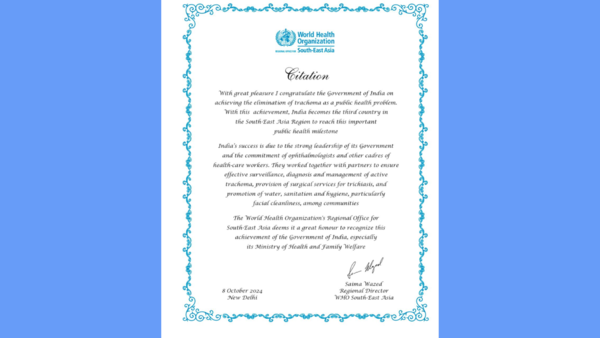The World Health Organisation (WHO) has felicitated the Indian government for eliminati ng a serious bacterial infection, trachoma. “India’s success is due to the strong leadership of its Government,” said Saima Wazed, Regional Director of WHO South-East Asia. Elimination of trachoma is part of the 2021–2030 neglected tropical disease roadmap by the WHO which targets the prevention, control elimination, and eradication of 20 diseases and disease groups by 2030.
The Union government had declared the country free from infectious trachoma and active trachoma in children. The findings of the National Trachoma Prevalence Surveys and Trachoma Rapid Assessment Surveys conducted from 2014 to 2017 showed that the overall prevalence of active trachoma was 0.7 per cent.

“India receives a citation from @WHOSEARO at the ongoing 77th Regional Conference for eliminating Trachoma as a public health problem. The award was received by Smt. Aradhana Patnaik, AS & MD (NHM), Ministry of Health & Family Welfare. A significant milestone, this reaffirms the country’s commitment to eye health, disease prevention, and universal health coverage,” Ministry of Health has tweeted.
All about trachoma
Trachoma is a contagious bacterial infection that affects the eyes. It is caused by the bacterium Chlamydia trachomatis. It is a leading cause of blindness worldwide through an infectious disease. It is particularly prevalent in impoverished areas with poor sanitation and limited access to clean water. The bacterial infection spreads through direct contact with the eyes or nasal discharges of the infected individuals. It is transmitted via flies that come into contact with these secretions.
Trachoma begins with conjunctivitis, also known as “pink eye,” and if untreated, repeated infections can cause the inner eyelid to scar. This scarring leads to a condition called trichiasis, where the eyelashes turn inward and scrape against the cornea, causing pain, damage, and eventually blindness.
Trachoma is preventable and treatable in its early stages through antibiotics like azithromycin. Improvements in hygiene, access to clean water, and sanitation are key strategies for controlling the spread of the disease.
India is the fourth country in Southeast Asia, after Nepal, Myanmar, and Pakistan to achieve the feat. Meanwhile, Bhutan was also felicitated for achieving interim targets for cervical cancer elimination; Timor-Leste for eliminating lymphatic filariasis; Maldives and Sri Lanka for Hepatitis B control in children; and six countries for achieving SDG and global targets for reducing under-five mortality and stillbirth rates.







